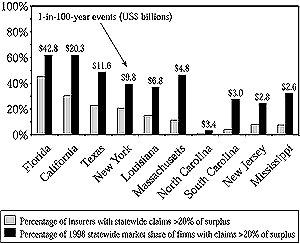15.2.6. Tourism and Recreation
|

Figure 15-5: Insured natural disaster losses have increased 10-fold
in North America between 1969 and 1999 (based on 5-year running mean).
Data include nonweather-related losses (~15% of total). Sources: Emergency
Preparedness Canada, 2000; Kunreuther and Roth, 1998 (United States).
|
Tourism is a major sector of the global economy, with
global receipts from international tourism of US$439 billion in 1998. With a
projected annual growth rate of 6.7%, annual international tourism expenditures
are expected to surpass US$2 trillion by 2020 (WTO, 1998). The United States
and Canada were among the top 10 tourism destinations in terms of international
tourist arrivals, with related 1998 receipts of US$71 billion and US$9 billion,
respectively (WTO, 1999). Domestic tourism is many times more important in terms
of participation and economic activity. The magnitude of the implications of
climate change for the tourism and recreation sector will depend on the distribution
and importance of tourism and recreation phenomena and the characteristics of
climate change and variability. In the United States, the Pacific and south
Atlantic regions are major providers of tourism and recreation opportunities.
However, if population distribution is taken into consideration, less populated
areas often have high economic dependence on tourism and recreation.
One critically important dimension of the tourism and recreation sector that
will be sensitive to climate change is the length of the operating season. Any
changes in season length would have considerable implications for the short-
and long-term viability of tourism and recreation enterprises. In Canada, where
43% of domestic and 62% of international tourism expenditures take place in
July through September, an extended warm-weather recreation season is likely
to be economically beneficial (Wilton and Wirjanto, 1998). The limited regional
studies of golfing, camping, and boating that are available reinforce this conclusion
(Wall, 1998a,b). This positive outlook must be tempered with the possibility
that economic benefits may occur at the expense of increased environmental deterioration,
as destinations host more visitors for longer periods of time. These concerns
will be particularly relevant for national parks and other natural areas, which
may need to establish "no-go" zones or visitation limits.
Conversely, winter recreations—such as downhill skiing, cross-country
skiing, snowmobiling, ice fishing, and other activities that are dependent on
snow or ice—as well as the businesses and destination areas associated
with them are likely to be impacted negatively. Case studies from the Great
Lakes (McBoyle and Wall, 1992) and New England (Bloomfield and Hamburg, 1997)
regions indicate that the vulnerability of ski resorts will differ considerably,
depending on location (latitude and altitude) and adaptations (snowmaking) to
offset or compensate for the effects of less reliable snow conditions. Another
potential adaptive strategy is diversification of activities to ensure that
investments in property and infrastructure generate income and employment for
much of the year. Without analysis of the impacts of altered snow conditions
for major ski areas in the mountain ranges of western Canada and the United
States and the large snowmobile industry in both nations, the economic impact
to the winter recreation sector in North America remains uncertain.
Perhaps as important as changes to season length will be the impact of climate
change on the availability and quality of the resource base on which recreational
activities depend. Below-average Great Lakes water levels in 1999 again revealed
the sensitivity of marinas and the substantial recreational boating industry
to climate variability. Similarly, the impact of the 1988 drought on Prairie
wetlands and waterfowl breeding success is illustrative of the potential impact
of climate change for this sport-hunting resource. Global warming is anticipated
to modify many other ecosystems on which outdoor recreations depend. Parks and
other natural areas are important tourism and recreation resources whose attractions
are based to a considerable extent on the species they conserve and the ecological
processes they sustain. A climate change assessment of Canada's National
Park system (Scott and Suffling, 2000) indicates that 75-80% of the parks
would experience a shift in dominant vegetation under 2xCO2 scenarios.
Analysis of vegetation response in the Yellowstone National Park region in the
United States revealed regional extinctions and the emergence of communities
with no current analog (Bartlein et al., 1997). Moreover, a global analysis
of habitat change resulting from climate change found that more than 50% of
the territory of seven Canadian provinces and greater than 33% of the territory
in 11 U.S. states are at risk (Malcolm and Markham, 2000). Although this will
pose an unprecedented challenge to the conservation mandate of protected areas,
the impact of ecological changes on tourism remains uncertain.
|

Figure 15-6: Ratio of property/casualty insurance premiums
to catastrophe losses. This measure of exposure ranges from 180:1
in 1974 to 52:1 in 1999, with a minimum value of 27:1 in 1992
(the year of Hurricane Andrew). For Canada, the high value is
161:1 in 1990, and the low value is 37:1 in 1999. U.S. premiums
are from AM Best and insured natural catastrophe loss figures
are from Property Claims Service (Kunreuther and Roth, 1998).
Canadian premiums are from Insurance Bureau of Canada (2000) and
losses are from Emergency Preparedness Canada (2000). Note that
premiums include revenues from nonweather-related business segments.
|
|
|

Figure 15-7: Vulnerability of U.S. insurers to 100-year
events, represented as combined effect of loss magnitude and insurance
company capacity (GAO, 2000). This analysis assumes that all insurers
place and price policies identically. It excludes reinsurance,
as well as local government-supported insurance or reinsurance
programs in California and Florida. It also excludes effects of
catastrophes striking more than one state (e.g., estimated 1-in-100-year
loss for the entire United States is $155 billion). Capacity implied
may include some surplus amounts that are not available for paying
natural catastrophe claims. Losses that result in claims of more
than 20% of surplus trigger initial stage of formal solvency review
by National Association of Insurance Commissioners. Puerto Rico
(not shown) has a 1-in-100-year loss of US$27.1 billion.
|
|
Continues on next page
|